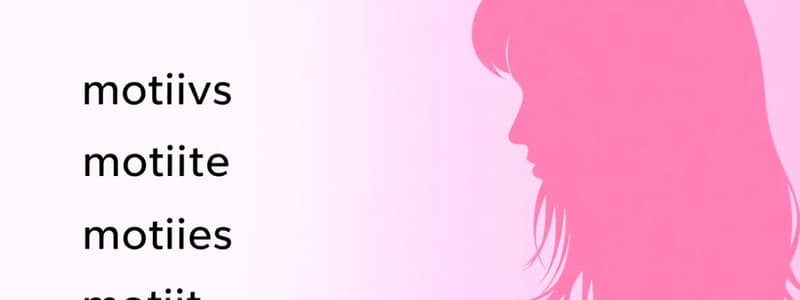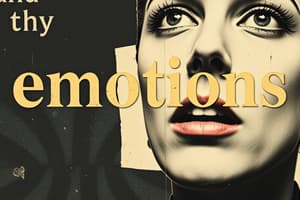Podcast
Questions and Answers
What is the key difference between motives and emotions?
What is the key difference between motives and emotions?
- Motives are typically brief and intense, while emotions are longer-lasting and less intense.
- Motives are always accompanied by emotions, while emotions are not always accompanied by motives.
- Motives are triggered by internal circumstances, while emotions are triggered by external circumstances. (correct)
- Emotions are always directed towards particular objects, while motives are not.
Which of the following is NOT a characteristic typically associated with emotions?
Which of the following is NOT a characteristic typically associated with emotions?
- They are usually about something or someone.
- They are often conceptualized as discrete categories.
- They can involve multiple component systems.
- They often last for hours or even days. (correct)
According to William Wordsworth, how does poetry relate to emotion?
According to William Wordsworth, how does poetry relate to emotion?
- Poetry is a means of creating new emotions through the recollection of past ones. (correct)
- Poetry is an attempt to recreate and purify past emotions.
- Poetry is a way to express emotions in a controlled and refined manner.
- Poetry is an expression of universal emotions that all humans experience.
What is the primary focus of the text when discussing emotions?
What is the primary focus of the text when discussing emotions?
What is the most likely reason for the quote "… everyone knows what an emotion is until asked to give a definition. Then, it seems, no one knows…” (Fehr & Russell, 1984) at the beginning of the text?
What is the most likely reason for the quote "… everyone knows what an emotion is until asked to give a definition. Then, it seems, no one knows…” (Fehr & Russell, 1984) at the beginning of the text?
The text suggests that emotions are complex responses. Which of these aspects does the text NOT explicitly mention as a component of emotion?
The text suggests that emotions are complex responses. Which of these aspects does the text NOT explicitly mention as a component of emotion?
Which of the following statements would the author MOST likely agree with considering the definition of emotion provided in the text?
Which of the following statements would the author MOST likely agree with considering the definition of emotion provided in the text?
The text mentions that emotions are often conceptualized as "discrete categories." Which of the following is NOT a typical example of such a "discrete category" of emotion?
The text mentions that emotions are often conceptualized as "discrete categories." Which of the following is NOT a typical example of such a "discrete category" of emotion?
How do collectivist cultures primarily influence emotional experiences?
How do collectivist cultures primarily influence emotional experiences?
In individualistic cultures, what aspect of emotions is most significantly affected?
In individualistic cultures, what aspect of emotions is most significantly affected?
What is the primary focus of positive psychology?
What is the primary focus of positive psychology?
According to the Broaden & Build Theory, what is the outcome of positive emotions?
According to the Broaden & Build Theory, what is the outcome of positive emotions?
What defines individual uniqueness in individualistic cultures regarding emotions?
What defines individual uniqueness in individualistic cultures regarding emotions?
How does positive psychology relate to resilience according to the provided content?
How does positive psychology relate to resilience according to the provided content?
Which statement about emotions and culture is true?
Which statement about emotions and culture is true?
What is one of the benefits attributed to positive emotions according to research?
What is one of the benefits attributed to positive emotions according to research?
How are cognitive appraisals in emotion processes similar to other types of cognition?
How are cognitive appraisals in emotion processes similar to other types of cognition?
What is the role of the amygdala in the appraisal process?
What is the role of the amygdala in the appraisal process?
Which of the following is NOT a function of subjective experience in emotion?
Which of the following is NOT a function of subjective experience in emotion?
What is the main idea behind the statement "Preferences needs no inferences"?
What is the main idea behind the statement "Preferences needs no inferences"?
Which of the following best describes the relationship between current feelings and attention?
Which of the following best describes the relationship between current feelings and attention?
Flashcards
Cultural Differences in Emotions
Cultural Differences in Emotions
Cultural differences in emotions stem from how values associated with collectivism and individualism shape emotional experiences.
Collectivist Cultures
Collectivist Cultures
Collectivist cultures focus on relationships, interdependence, and connectedness.
Individualist Cultures
Individualist Cultures
Individualist cultures emphasize individual separateness, independence, and self-reliance.
Appraisal Process in Emotion
Appraisal Process in Emotion
Signup and view all the flashcards
Regulation Strategies in Emotion
Regulation Strategies in Emotion
Signup and view all the flashcards
Positive Psychology
Positive Psychology
Signup and view all the flashcards
Broaden-and-Build Theory
Broaden-and-Build Theory
Signup and view all the flashcards
Positive Emotions
Positive Emotions
Signup and view all the flashcards
Unconscious Appraisals
Unconscious Appraisals
Signup and view all the flashcards
Amygdala's Role in Appraisals
Amygdala's Role in Appraisals
Signup and view all the flashcards
Cognitive Appraisal
Cognitive Appraisal
Signup and view all the flashcards
Feelings Guide Attention
Feelings Guide Attention
Signup and view all the flashcards
Subjective Experience of Emotion
Subjective Experience of Emotion
Signup and view all the flashcards
What is an Emotion?
What is an Emotion?
Signup and view all the flashcards
What is a Motive?
What is a Motive?
Signup and view all the flashcards
What is an Emotion?
What is an Emotion?
Signup and view all the flashcards
What is a Mood?
What is a Mood?
Signup and view all the flashcards
What is an Emotion?
What is an Emotion?
Signup and view all the flashcards
Study Notes
Emotion
- Emotion is defined as a complex, multi-component response to changes in how people interpret or appraise their current circumstances.
- There's a vital relationship between present and past experience.
- Emotions are often described as arising from both internal (motivations) and external (situational) factors, but some distinctions are debatable.
- Emotions and moods are frequently contrasted based on duration and specific cause.
- Appraisals, or interpretations of the situation, are a central element of emotion. Different interpretations lead to different emotional responses.
- Emotions can arise as a result of physical physiological arousal and cognitive interpretations of that arousal.
- A two-factor theory of emotions was proposed by Schachter and Singer in 1962 (emotions are the result of a combination of an initial state of unexplained arousal and cognitive explanation).
- Misattribution of arousal can occur, where physiological arousal is incorrectly connected to an unrelated event, intensifying the emotional response to that new event.
- Cognitive appraisals are important because they differentiate among emotions.
- The core relational themes, as well as dimensional aspects, of appraisals are described separately in the lectures.
- Cognitive appraisals precede and cause the components of emotions, leading to the subjective experience of the emotion and associated arousal.
- Minimalist appraisal theories reduce the number of appraisal dimensions.
- Dimensional appraisal theories identify a range of appraisal dimensions relevant to the differences among emotions.
- Emotions involve multiple components, including subjective experience, thought-action tendencies, bodily changes, facial expression, responses to emotion, and a person-environment relationship.
Bodily Changes
- Intense negative emotions activate the sympathetic nervous system, leading to physiological changes (e.g. increased heart rate, respiration).
- People's perceptions of their own physiological arousal intensifies emotional responses (visceral perception).
- The James-Lange theory suggests that autonomic arousal is responsible for differentiating emotions.
- Cannon (1927) critiqued the James-Lange theory, suggesting internal changes occur too slowly to be the primary source of feelings, while also pointing out that artificially inducing bodily changes doesn't always produce an emotion.
Facial Expression
- Facial expressions communicate emotions, often evoking similar emotions in others.
- Darwin's work on emotional expression highlights the survival value of communicating emotions.
- Display rules are culturally determined norms that influence how emotions are expressed.
- The facial feedback hypothesis states that facial expressions can directly influence emotional experience.
Cognitive Appraisal
- Cognitive appraisals are conscious and unconscious processes.
- The amygdala plays a key role in automatic appraisals, supporting the idea that appraisals can occur outside of conscious awareness.
- Cognitive appraisals in emotions are similar to other types of cognition.
- An emotion is more than just the feeling, it's also a product of a process, where subsequent components unfold and change over time.
Subjective Experiences
- Subjective experiences of emotion are within awareness.
- Affective states influence personal experience.
- Feelings serve as feedback about the personal relevance of current circumstances, guiding behavior.
- Current feelings influence attention and learning.
- Feelings affect evaluations and judgment of risk.
Thought & Action Tendencies
- Thought-action tendencies are the cognitive and behavioral responses spurred by emotions.
- Negative emotions typically trigger specific, narrow thought-action tendencies related to survival.
- Positive emotions involve broad, more open thought-action tendencies, promoting actions that support ongoing goals and survival.
Emotion Regulation
- Emotion regulation involves a person's responses to their own emotions, including efforts to intensify or minimize emotions.
- Successful emotion regulation is linked to social success.
- Antecedent-focused strategies and response-focused strategies are common ways to regulate emotions, based on when they are implemented.
- Strategies to regulate emotions (diversion and engagement) have different effects on various components of the emotional response, cognitive function, and the autonomic nervous system.
- Reappraisal, or changing one's perspective, is an effective strategy for regulating emotions.
Emotions, Gender & Culture
- Gender and cultural differences may influence emotion in various ways.
- The way people's emotions are expressed and when differs across cultures.
- Gender and cultural beliefs affect appraisals (expectations and interpretations of events) of emotions and emotional responses and expressions.
Positive Psychology
- Positive psychology explores human flourishing and potential, rather than dysfunction.
- Studies reveal that positive emotions have diverse positive outcomes, from boosting health to improving cognitive processes like attention.
- The broaden-and-build theory of positive emotions links positive emotions to psychological growth, survival, and increased resilience. This theory proposes that positive emotions broaden the scope of people's attention, thought-action patterns, and relationships.
Studying That Suits You
Use AI to generate personalized quizzes and flashcards to suit your learning preferences.




